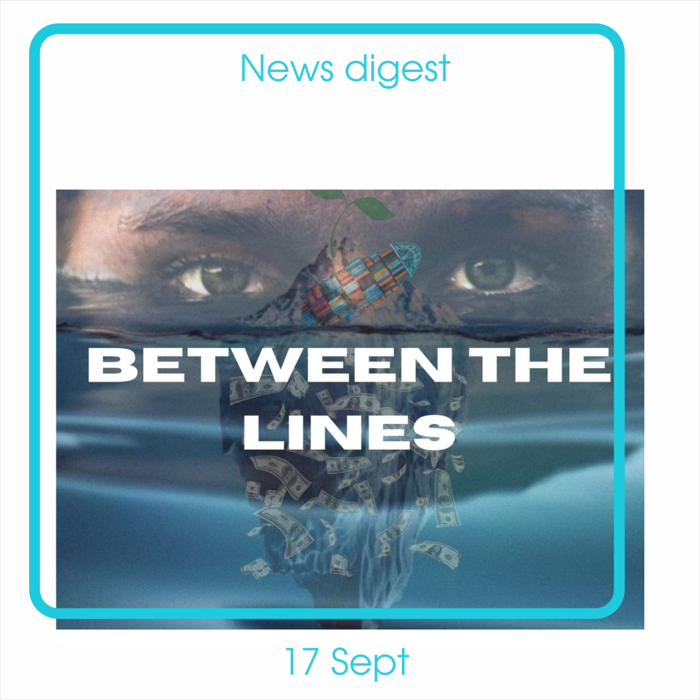News digest. 17 Sept
What is behind the noble intention of partnerships extension? Faster reach of the green future, stronger assets or… both?
No sooner did Chinese ports started to reopen than experts rushed to evaluate the potential financial losses that could have been carried out by the companies. It has been stated that if the situation had not started to gradually improve, the closure of Ningbo and Shanghai could have disrupted more than $14 billion of trade flows. No wonder – the ports are one of the main hubs for companies from all over the world and those relying on just-in-time supply chain methods usually worry the most when ports shut down. That is why the relief in the Asian part cannot calm the racing heartbeat of the industry players when it is still dark and gloomy above the West Coast, where 40% of ships are being required to anchor. In the big picture, container call sizes are currently up between 10% and 70% across all major US, Northern European, and Asian ports, which continue to cause delays.
Following Maersk’s active calls for net-zero carbon emissions, the second member of the 2M alliance, MSC, has backed its partner’s initiative, claiming that the need for green technologies is stronger than ever. Success will be possible thanks to a scalable fuel, which requires… partnerships. Is there something between the lines that we cannot grasp? The persistent reminders about joint efforts have become a part of the giants’ agenda, so the question is whether there is something more to it than a noble strive for decarbonization? Further expansion of assets? The trend for partnerships has been in the air for a while now, (not only regarding sustainability) and recently the market has welcomed some new ones – CMA CGM has agreed to form a €25mil commercial partnership with Brittany Ferries. In turn, in order to further develop and strengthen its logistics services In Europe, DFDS has fully acquired the Danish freight forwarder ICT Logistics. We can only guess what the real intentions of the joint efforts are, especially when it seems like in the near future big companies will lean to more subtle moves. Although COSCO has settled the case with MCS Industries regarding market manipulations and its failure to stick to its contractual commitments with MCS, its conflict with MSC remains yet to be resolved. The situation is heating up in the wake of a complaint filed by North America Inc. with FMC, claiming CMA CGM and FMS charged exorbitant detention and demurrage (D&D) fees for more than a dozen containers. FMS assessed the D&D charges for consignment one at $58,220, which Eucatex was forced to pay before it could collect the cargo. Did someone say a “fair game”?
Perhaps, maybe this is why the main players have started to decrease their appetite for spot rates growth? One can only hope. At least Hapag-Lloyd has become the second container carrier that announces the suspension in rate increases after CMA CGM. There is no deadline for such a move; the company just hopes the market will eventually calm down and then it will be able to redesign its approaches. Whether it will bring the desired result is uncertain, the disruptions depend on other factors driving the current chaos. For example, what is not contributing to stability is the behavior of carriers that blank nearly half of all Asia – Middle East sailings. The thing is that alliances and consortia continuously shift capacities between tradelanes to adapt to changes in demand even if there are no real changes in demand, and who are those unable to keep up with the insane pace? Secondary services. The gold rush makes big ocean carriers continue to redeploy tonnage onto more lucrative east-west tradelanes, leaving shippers on lower-paying routes without a regular liner service. This situation? Paired with the congested ports? A disaster. Retailers are howling for the government’s’ help in unison with smaller companies. In the US, a coalition of 152 companies and trade associations has submitted a letter of support to Congress regarding lines’ supremacy that has to be stopped. Otherwise, American producers will keep paying the price.
Meanwhile, Europe is getting ready for the rail breakthrough after the series of misfortunate strikes and an overall decrease in the number of significant rail freight developments. Belgium comes into the spotlight by presenting the Rail Roadmap 2030, a new conceptamid to identify the steps needed to enable a doubling of rail transport in the next ten years. Longer trains, digitization, and electrification of the track in the port of Antwerp are part of the plan. The UK hops on the train of advances with DP World commitments to investing $415 million to add a fourth Berth at London’s Gateway Logistics Hub in order to help strengthen the UK’s supply chain resilience. Additionally, Britain also has the potential to make the headlines as the country with some leading sustainable construction materials business.

